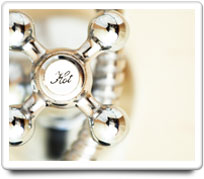Question Topic
Plumbing Unclogging Hot Water Line

Home-Wizard™ calculates your ideal home care program to avoid problems with your Plumbing, but sometimes trouble can still occur. Here are answers to questions about plumbing unclogging hot water line.
QUESTION FROM Jeremy
How can you unclog a hot water supply line leading to an upstairs shower without putting a hole in the wall?
ANSWER FROM HOME-WIZARD
Dear Jeremy:
The first step in determining how to unclog a water supply line is to try to determine what could be causing it. Example causes of poor water pressure include: 1) water pipes becoming clogged internally due to rust or mineral build-up due to hard water; 2) poor installation of the supply piping (for example, too much solder might have been pushed into a copper pipe joint during installation); or 3) problems with the faucet on this line.
If water pressure is good when you first open a faucet, but immediately falls off to a poor flow, then the system pressure is good but there is probably a constriction in the piping.
I assume that you have already checked to see if the low water pressure is only at the one upstairs shower? Otherwise the problem could be further up your piping system, instead of just isolated to your line serving the shower. The way to determine this is to one by one open up other hot water faucets throughout your house.
On the other hand, you should check to see if the problem could be caused by a problem with your shower's hot water faucet itself. For example, a broken "O-ring" on the faucet can clog the faucet internals and prevent good water flow. Since your problem seems to be just with the hot water supply, then you might want to check to see if you you have any damaged faucet parts in the hot water faucet, or if the inside of the hot water faucet has gotten clogged with minerals build-up.
Hope this is helpful.
Home-Wizard.com
FOLLOW-UP FROM Jeremy
It was white, mesh-like bebris clogging the hot side of the faucet.I un-cloggedd it and it has been working just fine, however, I still do not know what the mysterious debris is or where it came from. I am concerned that it may be from inside the hot water heater and that the heater may be deteriorating and need to be replaced. How can I confirm one way or the other?
ANSWER FROM HOME-WIZARD
Jeremy:
I would suspect that the debris that you found clogging the hot side of the faucet could have been in you system during construction, and then gotten flushed through and stuck in the faucet.
Regarding your concern about the source of the mesh-like debris being the hot water heater, one thing you can do to check is to back-flush your water heater, and see if any similar debris comes out. Here is a video that shows how to backflush a water heater:
http://www.home-wizard.com/LawOrderSMU.asp (the beginning is rather light-hearted, but if you skip ahead to the 2:35 mark, it describes the backflush process step-by-step).
If your water heater is more than 10 years old, then you might also want to have your water heater checked to see if the anode rod needs to be replaced. The anode rod is designed to protect the inside of your water heater from corrosion.
Hope this is helpful.
Home-Wizard.com
FOLLOW-UP FROM Jeremy
Thank you very much for the info and the video.
As a new homeowner I truly appreciate a point in the right direction. I am a new homeowner, however the house is twenty-two years old. I did flush the hot water heater and the water was cloudy with small pieces of sand and grit-like sediment that settled to the bottom and even smaller white flecks that floated and appeared to be of the same material as the previously clogged faucet line.? I flushed the heater til the water was clear and there was no more sediment visible. Will probably have to replace my water heater sooner rather than later as most are only rated up to fifteen years, but I am trying to get as much life out of this one as I can. Just wanted to know if I could test the anode myself? I also wanted to know when replacing the elements becomes a viable option as it would be a far more cost effective solution when compared to replacing the entire heater? (Given that there is no internal corrosion, right?)
ANSWER FROM HOME-WIZARD
Jeremy:
Glad we are able to help you.
A couple of thoughts that might help you further. Since you said you just moved into your 22-year old house, it sounds like it will be hard to tell whether the previous owner was regularly backflushing your water heater. So you won't be able to tell whether the scale build-up you saw when you were backflushing is from the last 22 years, or last 22 months or last 22 weeks. The best way to check how fast the scale buildup occurs, is in about 3-4 months to backflush your water heater again, and see how much scale comes out. The harder your water, the more scale typically will build up.
Yes, since your water heater is likely 22 years old, and you don't know whether it was regularly backflushed, you might want to be be prepared to replace the unit if it starts to leak, or if you begin to see slow recovery, noisy operation, or no hot water. But if none of these are occurring, then it makes sense to check the anode and replace it necessary, so as to get a few more years out of your water heater.
Regarding replacing the anode yourself, here is a video which describes step-by-step how to replace the anode:
http://www.thisoldhouse.com/toh/video/0,,20047047,00.html
Hope this is helpful.
Home-Wizard.com
 Overview
Overview Routine Care
Routine Care Q & A
Q & A Articles
Articles



